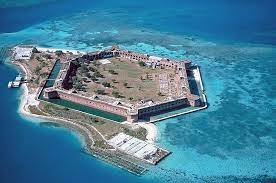The Florida Keys have a rich history dating back to the indigenous peoples who lived there thousands of years ago. Some of the most significant Florida Keys Historical Events include:
Ponce de León’s arrival in 1513: Juan Ponce de León arrived in Florida in 1513, marking the start of European exploration and colonization of the area. The Keys were used as a base for his explorations, and although he did not establish a permanent settlement there, his voyage set the stage for future European exploration and colonization of the region.
 The construction of Fort Jefferson in the Dry Tortugas: Fort Jefferson was built in the Dry Tortugas between 1846 and 1875 as a military fortress to protect shipping lanes in the Gulf of Mexico. It played a role in the Civil War and was used as a prison during the late 1800s, housing infamous prisoners such as Dr. Samuel Mudd, who was convicted of conspiracy in the assassination of President Abraham Lincoln.
The construction of Fort Jefferson in the Dry Tortugas: Fort Jefferson was built in the Dry Tortugas between 1846 and 1875 as a military fortress to protect shipping lanes in the Gulf of Mexico. It played a role in the Civil War and was used as a prison during the late 1800s, housing infamous prisoners such as Dr. Samuel Mudd, who was convicted of conspiracy in the assassination of President Abraham Lincoln.Roughing it on Garden Key in the Dry Tortugas
The founding of Key West as a naval base: Key West was established as a naval base in the Civil War by the Union’s Gulf Blockading Squadron to cut off Confederate trade routes. It became a major naval base during the Spanish-American War and both World War I and World War II.
 The development of the Key West-Havana cigar trade: In the late 1800s, Key West became a major center for cigar production, with many Cuban cigar makers settling in the city. The Key West-Havana cigar trade was an important source of revenue for the city, and Key West was known as the “Cigar Capital of the World.”
The development of the Key West-Havana cigar trade: In the late 1800s, Key West became a major center for cigar production, with many Cuban cigar makers settling in the city. The Key West-Havana cigar trade was an important source of revenue for the city, and Key West was known as the “Cigar Capital of the World.”The building of the Overseas Railroad: The Overseas Railroad was built in the early 1900s, connecting Key West to mainland Florida. The railway was a major engineering feat, and its completion made travel to the Keys much easier and opened up the area to tourism and development.
Riding the Florida Keys Over-Sea Railroad – Video
The 1935 Labor Day hurricane: The 1935 Labor Day hurricane was one of the most devastating natural disasters to hit the Keys, resulting in over 400 deaths. The storm destroyed much of the infrastructure in the area and had a lasting impact on the region’s economy and environment.
80 Years Later: Great Labor Day Hurricane of 1935
Key West’s transformation into a naval base during World War II: Key West was a major naval base during World War II, and the military presence had a significant impact on the city and the surrounding area. The base brought jobs and economic growth to the region, and many veterans chose to settle in the Keys after the war.
The Cuban Revolution and arrival of refugees: The Cuban Revolution in 1959 led to the arrival of many Cuban refugees in the Keys. This influx of refugees brought new cultures, traditions, and influences to the region, and had a lasting impact on the area’s economy and society.
The growth of tourism: The completion of the overseas highway in the early 1950s made travel to the Keys much easier, and this, combined with the natural beauty of the area, led to a boom in tourism. The growth of tourism had a significant impact on the region’s economy and infrastructure, and the Keys became a popular destination for vacationers and retirees.
 Environmental and conservation efforts: In the latter part of the 20th century, there was a growing awareness of the need to protect the environment and wildlife of the Keys. This led to the creation of the Key Deer National Wildlife Refuge and the Florida Keys National Marine Sanctuary, which protect the unique ecosystems of the region and preserve them for future generations.
Environmental and conservation efforts: In the latter part of the 20th century, there was a growing awareness of the need to protect the environment and wildlife of the Keys. This led to the creation of the Key Deer National Wildlife Refuge and the Florida Keys National Marine Sanctuary, which protect the unique ecosystems of the region and preserve them for future generations.You Can Help Key Deer – Leave Them Alone
